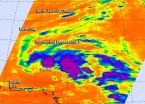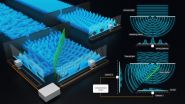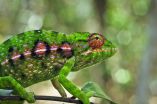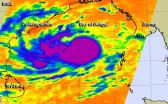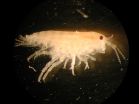(Press-News.org) SAN DIEGO – Telling youths who are juggling multiple electronic devices to "focus on the task at hand" may not always be good advice, according to research to be presented by two high school students on Saturday, Oct. 11 at the American Academy of Pediatrics (AAP) National Conference & Exhibition.
Sarayu Caulfield and Alexandra Ulmer, seniors at Oregon Episcopal School in Portland, Ore., will present their study "Capacity Limits of Working Memory: The Impact of Media Multitasking on Cognitive Control in the Adolescent Mind" from 1-1:30 p.m. in Marina Ballroom Salon E at the San Diego Marriott Marquis.
Contrary to popular belief that multitasking leads to poor performance, the young researchers found the opposite is true for adolescents who spend a lot of time switching between media devices and tasks.
"Maybe practice really does make perfect," Ms. Ulmer said.
"In our current multimedia environment, there are people who are multitasking at an exceedingly high rate, and the reality is that they may have become really good at it," Ms. Caulfield added.
To study how media multitasking affects adolescents' ability to process information, the young researchers recruited 196 females and 207 males ages 10-19. All participants answered questions about their daily media habits and completed the Stanford Multitasking Media Index, which assesses how often a person multitasks (e.g., texts, instant messages and emails at the same time).
Participants then completed tests to assess their ability to switch between tasks and to focus on a single task. They were randomly assigned to complete these tasks sequentially with no distractions (non-multitasking) or simultaneously with auditory, visual and cognitive distractions such as responding to emails (multitasking).
Results showed that those who scored low on the media multitasking index spent an average of about 20 minutes a day multitasking. They also averaged about 2.5 hours of homework per day and were multitasking 0.08% of this time. Meanwhile, those who scored high on the multitasking index averaged more than three hours per day of multitasking. They did homework for about 3.5 hours a day and juggled multiple tasks for more than 50% of this time.
When asked to complete the study tasks, high media multitaskers were better at filtering out distractions but performed worse when made to focus on a single task. Low multitaskers were less able to filter out distractions but focused better on single tasks.
"We must emphasize that most people performed best when focused on just one task," Ms. Caulfield said. "However, there was a group that provided us with an exception to that finding — the high media multitaskers."
Added Ms. Ulmer: "This study suggests that digital natives (adolescents who grew up with exposure to multiple media) with high multiple media use may have developed an enhanced working memory and perform better in distracting environments than when focused on a single task with no distractions. This could have a significant impact on teaching styles and curriculum."
INFORMATION:
The American Academy of Pediatrics is an organization of 62,000 primary care pediatricians, pediatric medical subspecialists and pediatric surgical specialists dedicated to the health, safety and well-being of infants, children, adolescents and young adults. For more information, visit http://www.aap.org.
SAN DIEGO – October 10, 2014. More than 90 percent of potential pediatric fractures are splinted improperly in emergency rooms and urgent care centers, which can lead to swelling and skin injuries, according to a study by researchers at the University of Maryland School of Medicine. The findings are being presented at the American Academy of Pediatrics (AAP) National Conference & Exhibition in San Diego.
The study looked at 275 cases involving children and teenagers up to the age of 18 who were initially treated in community hospital emergency rooms and urgent care ...
Ann Arbor, Mich. — A web-based system that allows preschools and child care centers to report illnesses to local public health departments could improve the detection of disease outbreaks and allow resources to be mobilized more quickly, according to University of Michigan research to be presented Saturday, Oct. 11 at the American Academy of Pediatrics (AAP) National Conference & Exhibition in San Diego.
Researchers who designed the biosurveillance system will describe how it can be used to track illness trends and improve public health response to outbreaks during ...
The seventh depression of the Atlantic Ocean Hurricane Season was born on Oct. 10, but it's subtropical. NASA's Aqua satellite looked at the developing depression in infrared light and saw strong thunderstorms within.
The Atmospheric Infrared Sounder or AIRS instrument aboard NASA's Aqua satellite captured data on developing Subtropical Depression 7 on Oct. 10 at 05:41 UTC (1:41 a.m. EDT). AIRS identified several areas of strong thunderstorms around the developing center of circulation. Some of those thunderstorms were high in the troposphere with cloud top temperatures ...
Observing the quantum behavior of light is a big part of Alan Migdall's research at the Joint Quantum Institute. Many of his experiments depend on observing light in the form of photons---the particle complement of light waves---and sometimes only one photon at a time, using "smart" detectors that can count the number of individual photons in a pulse. Furthermore, to observe quantum effects, it is normally necessary to use a beam of coherent light, light for which knowing the phase or intensity for one part of the beam allows you to know things about distant parts of ...
BOSTON – Email has become one of the most widespread forms of communication, with its streamlined interactions benefiting both businesses and individuals. With the advent of secure patient web portals and the faith that online access has the potential to improve care, the medical industry is slowly catching up.
And while it may take time before it's known what impact email exchanges might have on patients and their care, a new study from Beth Israel Deaconess Medical Center (BIDMC) offers some early insights into the effects on doctors, suggesting that reimbursement ...
Super Typhoon Vongfong continued on its trek north through the Philippine Sea while slightly weakening on Oct. 10. NASA's TRMM and Aqua satellites provided forecasters with cloud extent, rainfall rates and distribution and more.
Vongfong was a super typhoon with wind maximum sustained winds of 145 knots (167 mph) when the TRMM satellite flew over on October 8, 2014 at 2328 UTC 7:28 p.m. EDT). TRMM's Microwave Imager showed that Vongfong was producing rainfall over a large area and heavy rainfall in the eye wall (the powerful thunderstorms around the open eye) and in multiple ...
DURHAM, N.C. –- No single "one-size-fits-all" model can explain how biodiversity hotspots come to be, finds a study of more than 700 species of reptiles and amphibians on the African island of Madagascar.
By analyzing the geographic distribution of Madagascar's lizards, snakes, frogs and tortoises, an international team of researchers has found that each group responded differently to environmental fluctuations on the island over time.
The results are important because they suggest that climate change and land use in Madagascar will have varying effects on different ...
NASA's Aqua satellite passed over Tropical Cyclone Hudhud on Oct. 10 as it reached hurricane-force.
The Atmospheric Infrared Sounder or AIRS instrument that flies aboard NASA's Aqua satellite read temperatures of thunderstorm cloudtops that make up Tropical Cyclone Hudhud when it passed overhead on Oct. 9 at 19:53 UTC (3:53 p.m. EDT). The data showed the coldest cloud top temperatures were in thunderstorms circling a developing eye. Cloud top temperatures were as cold as -63F/-53C, which have the potential for dropping heavy rainfall.
Hudhud's maximum sustained winds ...
Small cues that display a user's transaction history may help a website feel almost as interactive as chatting with an online customer service agent, paving the way for more cost-effective websites, according to researchers.
"One of the challenges with online interactivity is trying to imbue the site with a sense of contingency -- the back-and-forth feel of a real conversation," said S. Shyam Sundar, Distinguished Professor of Communications and co-director of the Media Effects Research Laboratory. "What we found is that providing some information about a user's interaction ...
A new study led by a Canadian marine zoologist reviews the world list of specialist driftwood talitrids, which so far comprises a total of 7 representatives, including two newly described species. These tiny animals with peculiar habits all live in and feed on decomposing marine driftwood. Dispersed across distant oceanic islands they use floating driftwood to hitch a ride to their destination. The study was published in the open access journal Zoosystematics and Evolution.
Tourists are familiar with talitrids as sandhoppers, found in burrows on sand beaches, or shorehoppers, ...
